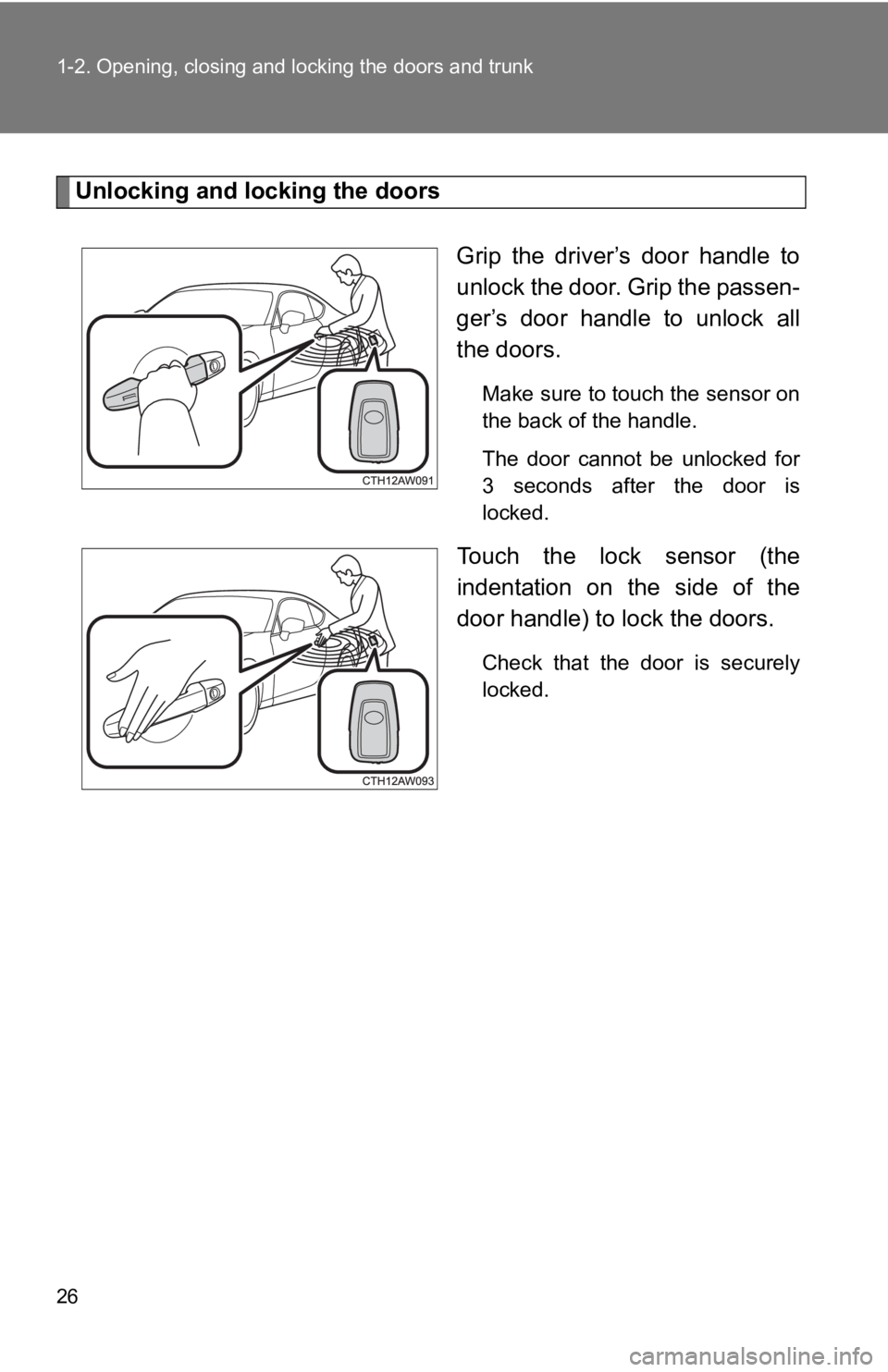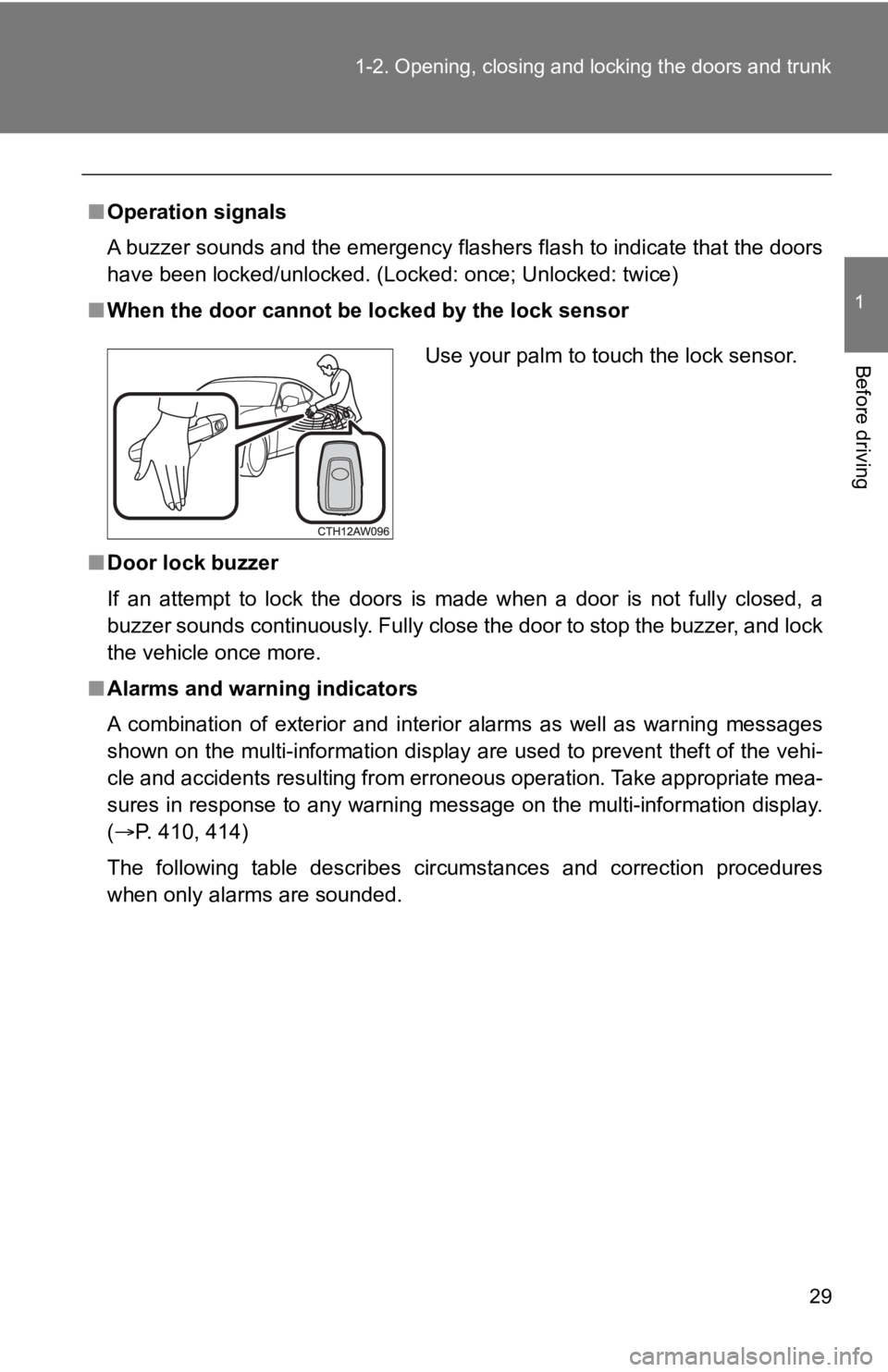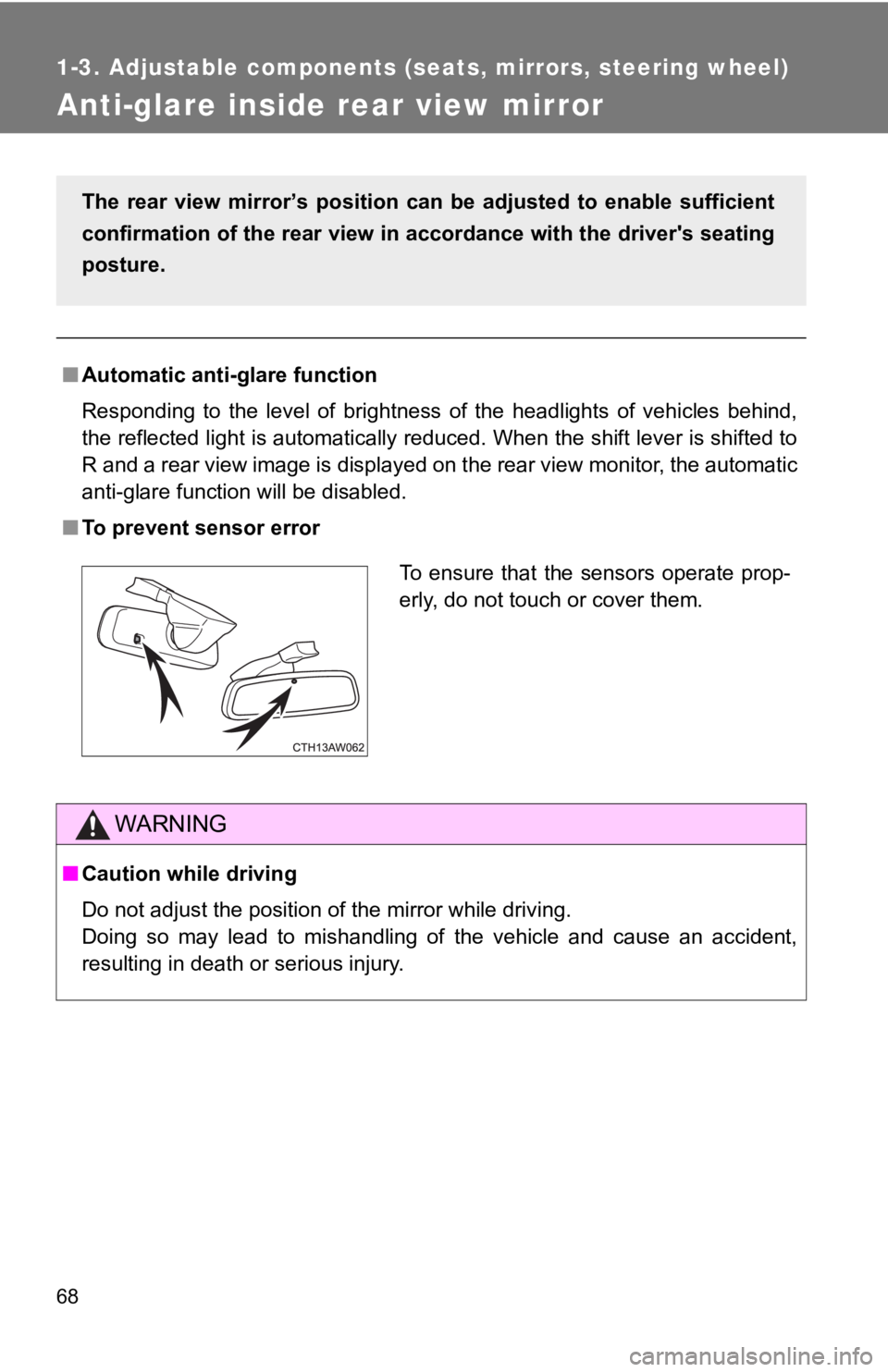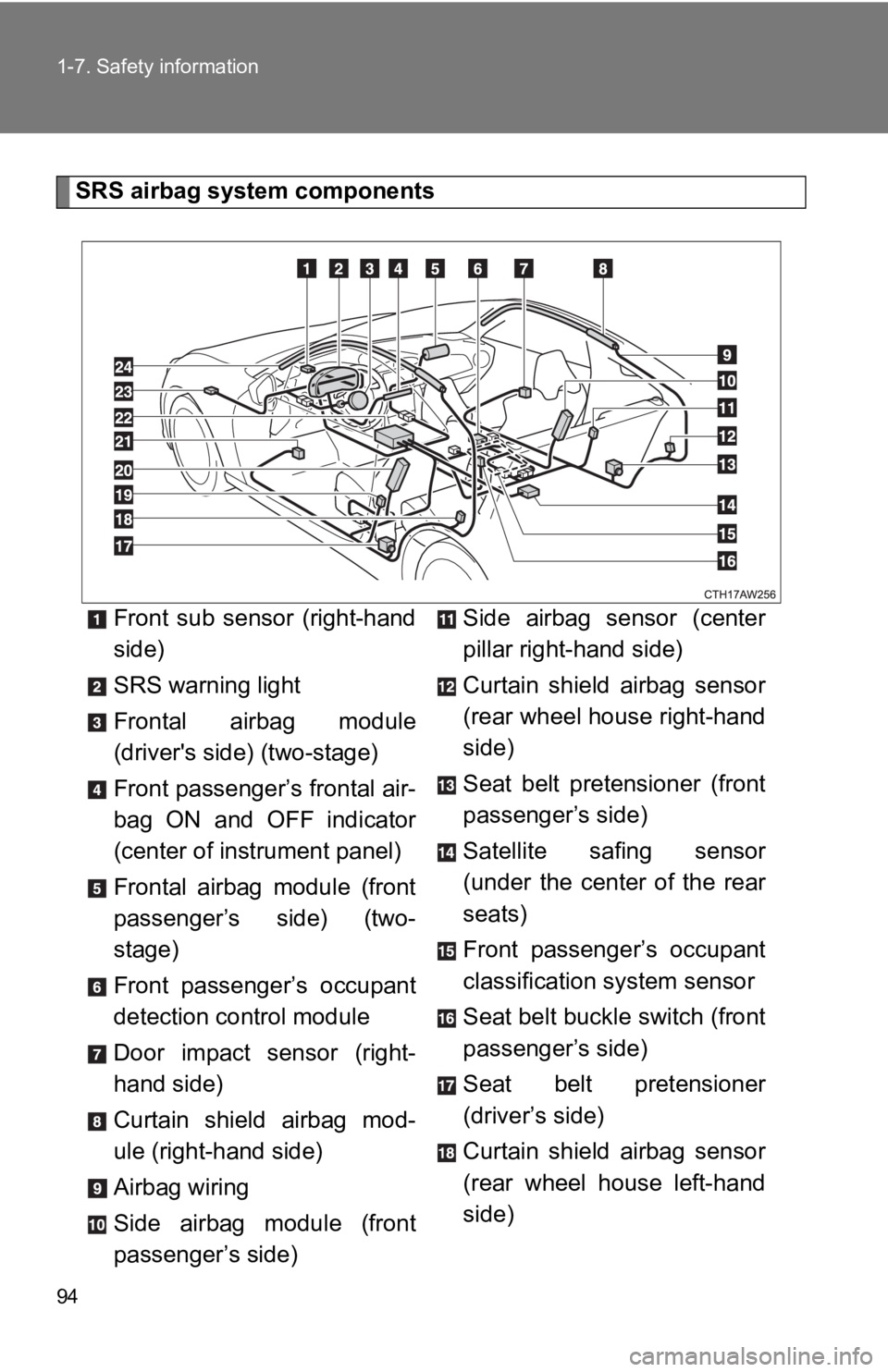sensor TOYOTA 86 2020 Owners Manual
[x] Cancel search | Manufacturer: TOYOTA, Model Year: 2020, Model line: 86, Model: TOYOTA 86 2020Pages: 532, PDF Size: 8 MB
Page 26 of 532

26 1-2. Opening, closing and locking the doors and trunk
Unlocking and locking the doorsGrip the driver’s door handle to
unlock the door. Grip the passen-
ger’s door handle to unlock all
the doors.
Make sure to touch the sensor on
the back of the handle.
The door cannot be unlocked for
3 seconds after the door is
locked.
Touch the lock sensor (the
indentation on the side of the
door handle) to lock the doors.
Check that the door is securely
locked.
Page 29 of 532

29
1-2. Opening, closing and locking the doors and trunk
1
Before driving
■
Operation signals
A buzzer sounds and the emergency flashers flash to indicate that the doors
have been locked/unlocked. (Locked: once; Unlocked: twice)
■ When the door cannot be locked by the lock sensor
■ Door lock buzzer
If an attempt to lock the doors is made when a door is not full y closed, a
buzzer sounds continuously. Fully close the door to stop the bu zzer, and lock
the vehicle once more.
■ Alarms and warning indicators
A combination of exterior and interior alarms as well as warnin g messages
shown on the multi-information display are used to prevent thef t of the vehi-
cle and accidents resulting from erroneous operation. Take appr opriate mea-
sures in response to any warning message on the multi-information display.
( P. 410, 414)
The following table describes circumstances and correction proc edures
when only alarms are sounded.
Use your palm to touch the lock sensor.
Page 33 of 532

33
1-2. Opening, closing and locking the doors and trunk
1
Before driving
■
Notes for locking the doors
●Touching the door lock sensor while wearing gloves may delay or prevent
lock operation. Remove the gloves and touch the lock sensor aga in.
● When the lock operation is performed using the lock sensor, rec ognition
signals will be shown up to two consecutive times. After this, no recogni-
tion signals will be given.
● If the door handle becomes wet when washing the vehicle while t he elec-
tronic key is within the effective range, the door may lock and unlock
repeatedly. In this case, place the electronic key in a locatio n 6 ft. (2 m) or
more away from the vehicle (take care to ensure that the key is not sto-
len), and continue to wash the vehicle.
● If the electronic key is inside the vehicle and a door handle b ecomes wet
during a car wash, a buzzer will sound outside the vehicle. To turn off the
alarm, lock all the doors.
● The lock sensor may not work properly if it comes into contact with ice,
snow, mud, etc. Clean the lock sensor and attempt to operate it again.
■ Notes for the unlocking function
●A sudden approach to the effective range or door handle may prevent the
doors from being unlocked. In this case, return the door handle to the
original position and check that the doors unlock before pullin g the door
handle again.
● Gripping the door handle when wearing a glove may not unlock the door.
Remove the gloves and touch the sensor on the back of the handle
again.
● If the door handle becomes wet when washing the vehicle while t he elec-
tronic key is within the effective range, the door may lock and unlock
repeatedly. In this case, place the electronic key in a locatio n 6 ft. (2 m) or
more away from the vehicle (take care to ensure that the key is not sto-
len), and continue to wash the vehicle.
● If there is another electronic key in the detection area, it ma y take slightly
longer to unlock the doors after the door handle is gripped.
Page 68 of 532

68
1-3. Adjustable components (seats, mirrors, steering wheel)
Anti-glare inside rear view mirror
■Automatic anti-glare function
Responding to the level of brightness of the headlights of vehicles behind,
the reflected light is automatically reduced. When the shift le ver is shifted to
R and a rear view image is displayed on the rear view monitor, the automatic
anti-glare function will be disabled.
■ To prevent sensor error
WARNING
■Caution while driving
Do not adjust the position of the mirror while driving.
Doing so may lead to mishandling of the vehicle and cause an ac cident,
resulting in death or serious injury.
The rear view mirror’s position can be adjusted to enable suffi cient
confirmation of the rear view in accordance with the driver's s eating
posture.
To ensure that the sensors operate prop-
erly, do not touch or cover them.
Page 94 of 532

94 1-7. Safety information
SRS airbag system componentsFront sub sensor (right-hand
side)
SRS warning light
Frontal airbag module
(driver's side) (two-stage)
Front passenger’s frontal air-
bag ON and OFF indicator
(center of instrument panel)
Frontal airbag module (front
passenger’s side) (two-
stage)
Front passenger’s occupant
detection control module
Door impact sensor (right-
hand side)
Curtain shield airbag mod-
ule (right-hand side)
Airbag wiring
Side airbag module (front
passenger’s side) Side airbag sensor (center
pillar right-hand side)
Curtain shield airbag sensor
(rear wheel house right-hand
side)
Seat belt pretensioner (front
passenger’s side)
Satellite safing sensor
(under the center of the rear
seats)
Front passenger’s occupant
classification system sensor
Seat belt buckle switch (front
passenger’s side)
Seat belt pretensioner
(driver’s side)
Curtain shield airbag sensor
(rear wheel house left-hand
side)
Page 95 of 532

95
1-7. Safety information
1
Before driving
Your vehicle is equipped with ADVANCED AIRBAGS designed based
on US motor vehicle safety standards (FMVSS208). The airbag sys
-
tem controls airbag deployment power for the driver and front p as-
senger. The front passenger's air bag system consists of the front
passenger occupant detec tion control module etc.
The main SRS airbag system components are shown above. The
SRS airbag system is controlled by the airbag control module. T he
airbag control module cons ists of an airbag sensor.
In certain types of severe front or side impacts, the SRS airba g sys-
tem triggers the airbag inflators. A chemical reaction in the inflators
quickly fills the airbags with non- toxic gas to help restrain t he motion
of the occupants.
Side airbag sensor (center
pillar left-hand side)
Side airbag module (driver’s
side)
Door impact sensor (left-
hand side) Airbag control module
(including impact sensors
and rollover sensors)
Front sub sensor (left-hand
side)
Curtain shield airbag mod-
ule (left-hand side)
■
If the SRS airbags deploy (inflate)
●Slight abrasions, burns, bruisi ng etc., may be sustained from S RS air-
bags, due to the extremely high speed deployment (inflation) by hot
gases.
● A loud noise and white powder will be emitted.
● Parts of the airbag module (steering wheel hub, airbag cover an d inflator)
as well as the front seats, parts of the front and rear pillars , and roof side
rails, may be hot for several minutes. The airbag itself may al so be hot.
● The windshield may crack.
Page 97 of 532

97
1-7. Safety information
1
Before driving
■
Driver’s SRS frontal airbag
The driver’s SRS frontal airbag uses a dual stage inflator. The inflator oper-
ates in different ways depending on the severity of impact.
Have the system inspected by your Toyota dealer immediately if the SRS
warning light illuminates.
NOTE
The driver’s SRS side airbag and SRS curtain shield airbag are not con-
trolled by the Toyota advanced frontal airbag system.
■ Front passenger’s SRS frontal airbag
The front passenger’s SRS frontal airbag uses a dual stage inflator. The
inflator operates in different ways depending on the severity of impact.
The occupant classification system sensor is installed under th e seat uphol-
stery and monitors the physique and posture of the front passen ger. Using
this information, the occupant classification system determines whether the
front passenger’s SRS frontal airbag should be deployed or not.
The occupant classification system may not inflate the front passenger’s
SRS frontal airbag even when the driver’s SRS frontal airbag de ploys. This
is normal. In this case, although the front passenger’s SRS fro ntal airbag
does not operate, the front passenger’s seat belt pretensioner operates with
the driver’s seat belt pretensioner. For details about the seat belt preten-
sioner, refer to “Seat belt pretensioners”. ( P. 61)
Observe the following precautions. Failure to do so may prevent the Toyota
advanced frontal airbag system from functioning correctly or ca use the sys-
tem to fail.
● Do not apply any strong impact to the front passenger’s seat.
● Do not spill liquid on the front passenger’s seat. If liquid is spilled, wipe it
off immediately.
● Do not remove or disassemble the front passenger’s seat.
● Do not install any accessory (such as an audio amplifier) other than a
genuine Toyota accessory under the front passenger’s seat.
● Do not place anything (shoes, umbrella, etc.) under the front p assenger’s
seat.
● Do not place a magnet near the seat belt buckle.
Page 98 of 532

98 1-7. Safety information
If the seat belt buckle switch and/or front passenger’s occupant classification
system have failed, the SRS warning light will illuminate. Have the system
inspected by your Toyota dealer immediately if the SRS warning light illumi-
nates.
If your vehicle has sustained impact, this may affect the proper function of
the Toyota advanced frontal airbag system. Have your vehicle in spected at
your Toyota dealer. Do not use the front passenger’s seat while driving the
vehicle to your Toyota dealer.
NOTE
The front passenger’s SRS side airbag and SRS curtain shield ai rbag are
not controlled by the Toyota advanced frontal airbag system.
■ Passenger’s frontal airba g ON and OFF indicators
P. 128
■ Occupant classification system
The occupant classification system sensor is installed under th e seat uphol-
stery and monitors the physique and posture of the front passen ger. Using
this information, the occupant classification system determines whether the
front passenger’s SRS frontal airbag should be deployed or not.
If the front passenger’s seat cushion is wet, this may adversel y affect the
ability of the system to determine deployment. If the seat cush ion is wet, the
front passenger should stop sitting on the front passenger’s se at. Wipe off
liquid from the seat immediately, let the seat dry naturally an d then check the
SRS warning light as follows.
● If the SRS warning light illuminates, keep the seat dry until t he warning
light turns off. If the SRS warning light stays on even when the seat has
dried, do not allow anyone to sit on the front passenger’s seat and have
the system checked by your Toyota dealer.
● If the SRS warning light does not illuminate, check that the fr ont passen-
ger’s frontal airbag ON and OFF indicators work properly. If th e indicators
do not work properly, do not allow anyone to sit on the front p assenger’s
seat and have the system checked by your Toyota dealer.
Page 104 of 532

104 1-7. Safety information
The SRS airbag can function only when the engine switch is in the “ON”
position (vehicles without a smart key system) or when the “ENGINE START
STOP” switch is in IGNITION ON mode (vehicles with a smart key system).
The Toyota advanced frontal airbag system is designed to determ ine the
activation or deactivation condition of the front passenger’s S RS frontal air-
bag depending on the characteristic of the item(s) or person on the front
passenger’s seat monitored by the front passenger’s occupant cl assification
system sensor. For this reason, only the driver’s SRS frontal a irbag may
deploy in the event of a collision, but this does not mean fail ure of the sys-
tem.
If the front sub sensors and the impact sensors in the airbag c ontrol module
detect a predetermined amount of force during a frontal collisi on, the control
module sends signals to the airbag module(s) (only driver’s mod ule or both
driver’s and front passenger’s modules) instructing the module( s) to inflate
the SRS frontal airbag(s).
The driver’s and front passenger’s SRS frontal airbags use dual stage infla-
tors. The two inflators of each airbag are triggered either seq uentially or
simultaneously, depending on the severity of impact, in the cas e of the
driver’s SRS frontal airbag and depending on the severity of im pact and the
characteristic of the item(s) or person on the seat in the case of the front
passenger’s SRS frontal airbag.
After deployment, the SRS airbag immediately starts to deflate so that the
driver’s vision is not obstructed. The time required from detec ting impact to
the deflation of the SRS airbag after deployment is shorter tha n the blink of
an eye.
Both when only the driver’s SRS frontal airbag deploys and the driver’s and
front passenger’s SRS frontal airbags deploy, the driver’s and front passen-
ger’s seat belt pretensioners operate at the same time.
Although it is highly unlikely that the SRS airbag would activa te in a non-
accident situation, should it occur, the SRS airbag will deflat e quickly, not
obscuring vision and will not interfere with the driver's abili ty to maintain con-
trol of the vehicle.
When the SRS airbag deploys, a sudden, fairly loud inflation no ise will be
heard and some smoke will be released. These occurrences are a normal
result of the deployment. This smoke does not indicate a fire i n the vehicle.
Page 111 of 532

111
1-7. Safety information
1
Before driving
■
Operation
The SRS side airbag and SRS curtain shield airbag can function only when
the engine switch is in the “ON” position (vehicles without a s mart key sys-
tem) or when the “ENGINE START ST OP” switch is in IGNITION ON mode
(vehicles with a smart key system).
The driver’s and front passenger’s SRS side airbags and SRS cur tain shield
airbags deploy independently of each other since each has its o wn impact
sensor. Therefore, they may not both deploy in the same acciden t. Also, the
SRS side airbag and SRS curtain shield airbag deploys independe ntly of the
driver’s and front passenger’s SRS front airbags in the steerin g wheel and
instrument panel.
A rollover sensor is also located inside the airbag control mod ule.
An impact sensor, which senses impact force, is located in each of the left
and right center pillars, doors and rear wheel houses. Another impact sen-
sor, which also senses impact force, is located under the center of the rear
seats.
If the impact sensor that is located under the center of the re ar seats and
one of the center pillar impact sensors or door impact sensors together
sense an impact force above a predetermined level in a side col lision, the
control module causes both the SRS side airbag and curtain shield airbag on
the impacted side to inflate regardless of whether the rear whe el house
impact sensor on the same side senses an impact.
If the impact sensor that is located under the center of the re ar seats and
one of the rear wheel house impact sensors together sense an im pact force
above a predetermined level, the control module causes only the SRS cur-
tain shield airbag on the impacted side to inflate.
If the rollover sensor detects rollover of the vehicle, the control module
inflates the SRS curtain shield airbags. At this time, the driver's and front
passenger’s seat belt pretensioners also operate at the same ti me.